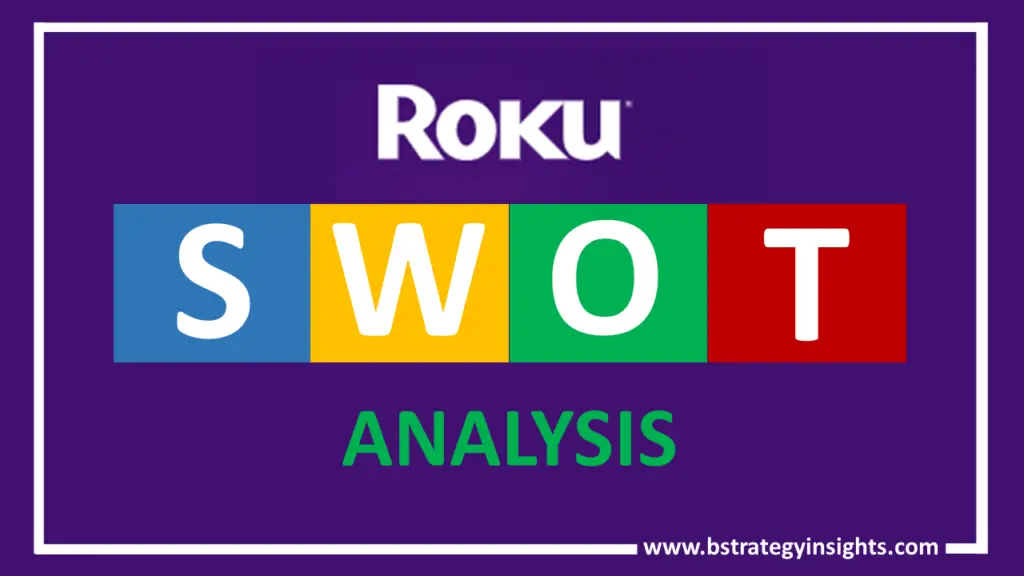
Roku Inc. is the pioneer of streaming to the TV; users can watch free or paid content on TV via the internet. Roku enables users to stream content they love, it enables content publishers to build large audiences and monetize them, it also provides advertisers with abilities for engaging with consumers. Movie and TV streaming services like Netflix, Hulu, Amazon Prime Video among others can be downloaded onto Roku devices. The most recent streaming devices to be released by Roku include The Roku Ultra, Roku Express 4k+, Roku Streaming Stick 4k+. Roku is able to serve its customers all around the globe through direct retail sales and through licensing agreements with service operators and TV OEMs.
SWOT analysis is a critical tool for Roku, in helping the brand examine its strengths in the market versus its weaknesses, its opportunities in the market, and the threats that the brand faces in the market. It is important that Medifast is armed with these critical insights in order to operate optimally both in its internal and external environment. Here is an overview of Roku’s SWOT analysis.
Roku Inc.– At a Glance
| Name | Roku, Inc. |
| Website | roku.com |
| Founders | Anthony Wood |
| Chief Executive Officer (C.E.O.) | Anthony Wood |
| Headquarters | San Jose, California, U.S. |
| Year Founded | October 2002 |
| Type of company | Public company |
| Revenues (FY 2020) | US$1.78 billion |
| Key Products/Services | Consumer electronics, Broadcast media: Roku: Roku Express, Roku Express+, Roku Ultra, Roku Streaming Stick, Roku TV, Roku OS |
| Key Competitors | Netflix, Sony, Hulu, Tivo, and Sling Media. |
Strengths of Roku
Strong customer base of 60.1 million users
In the face of a declining appetite for the traditional pay TV service model and with the ubiquitous nature of the internet, the world has seen a surge in demand for streaming TV. Approximately a third of households are now shifting to streaming TV.
In 2020 alone, Roku saw an increase of 14 million new users and had 58.7 billion streaming hours in 2020 and 73.2 hours in 2021. This huge customer base is a critical asset for the brand; at strengthens Roku’s brand equity and avails to the brand network effects that cumulatively ensure the brand earns more, gets more customers and lasts longer in the market.
Deep industry knowledge and insights
With the global paradigm shift of consumers, advertisers and content publishers to TV streaming, Roku has become the go-to brand for great innovations and expertise for TV streaming. Roku TV models and players make for the flagship products of Roku which are offered in a variety of models and sizes as well as picture qualities.
The brand, through innovation, has also added convenience through the addition of advanced features like Siri, Alexa, and Google assistant that has voice compatibility. Apart from the innovations made by the brand, over the years, the brand has gathered insights from its customers that enable it to better understand customers’ tastes and preferences. These insights are valuable and are the basis for the brand’s informed innovation and expertise.
Strong financial growth and base
Being a market leader and having greatly penetrated the US market, the brand has huge revenues and greater investment that are great for fuelling the brand’s expansion strategies. As a result, the brand has experienced continued growth of its revenues year over year. In 2018, the brand earned $0.743B a 44.8% increase from 2017; in 2019, the revenues rose by 52.04% to reach $1.129B; and in 2020, revenues rose by 57.
A leader in the industry
Roku is the leading smart TV operating system in both the US and in Canada; one in every three smart TVs in the US uses Roku for its operating system. Being a first entrant in the industry, the brand has the advantage of establishing strong brand recognition, using price-leader market strategies and customer loyalty before other brands enter into the same market.
Weaknesses of Roku
Limited geographical reach
Roku’s dealings and revenues are highly concentrated in the US. Over 90% of the brand’s revenues come from the US market. This is a weakness for the brand given that it is limited in earnings that it could have generated from other markets.
Netflix, for example, has 1.5 international subscribers as it has domestic ones. Another example is Alphabet; more than 50% of its revenues from digital advertising are generated from markets outside of the US. This is a sure limitation that the company should consider working on to boost its revenue generation.
Fall in share prices
Roku has seen a drop in its share prices in the first quarter of 2022. As of Thursday 17, February 2022, the shares had fallen by 20% after the company issued a video showing its fourth-quarter revenue and first-quarter revenue guidance. The company’s revenues slowed to a much lower rate than analysts anticipated. The drop in prices could scare away investors and limit the company’s expansion strategies.
Opportunities of Roku
International market expansion
There are many advantages for Roku to venture outside of its parent market. The company had already initiated plans for expansion into Brazil. There is a need for strengthening such strategic expansion strategies for increased revenues and profitability in potential markets.
Innovation
Technological innovation is a key tool for continued differentiation. In the current age where the barriers to entry for the TV streaming industry are low and many competitors are entering the market, Roku would raise its barriers to entry through innovation.
Threats of Roku
Stiff competition
Roku faces stiff competition from numerous companies in the industry, including Amazon, Netflix, Sony, Hulu, Tivo, and Sling Media. The brand faces competition in three regards: competition in streaming media players, competition for market share in TVOS market, and competition for the advertising business.
Competitors like Amazon are coming up strongly to content for a bigger space in all of the above areas of interest for Roku. Additionally, in the present era of ubiquitous connectivity, many companies are coming up to join the industry, thus increasing the threat of competition.
Limited market presence
Roku only has its market presence in the US. The US market is a target of many strong competitors against Roku that are all striving to get an increased share of the market; this would diminish Roku’s market share.
Additionally, the US market has experienced a huge surge in the streaming market; but in the event of market maturity, there will be no room for expansion, and therefore, Roku may suffer from stagnation in profitability and revenues, which could threaten the existence of the brand.
Lastly, if there is an adverse occurrence in the US market, there will be no other market to fall back to until the adverse effects in the parent market are addressed. This too spells out a threat to Roku.
Conclusion
Roku, being a leader in the industry, has a huge advantage of strong brand recognition and customer loyalty. The brand however faces stiff competition in its parent market. There is a need to ward off competition through innovation and great customer service. The company should also consider expansion into a new market.



